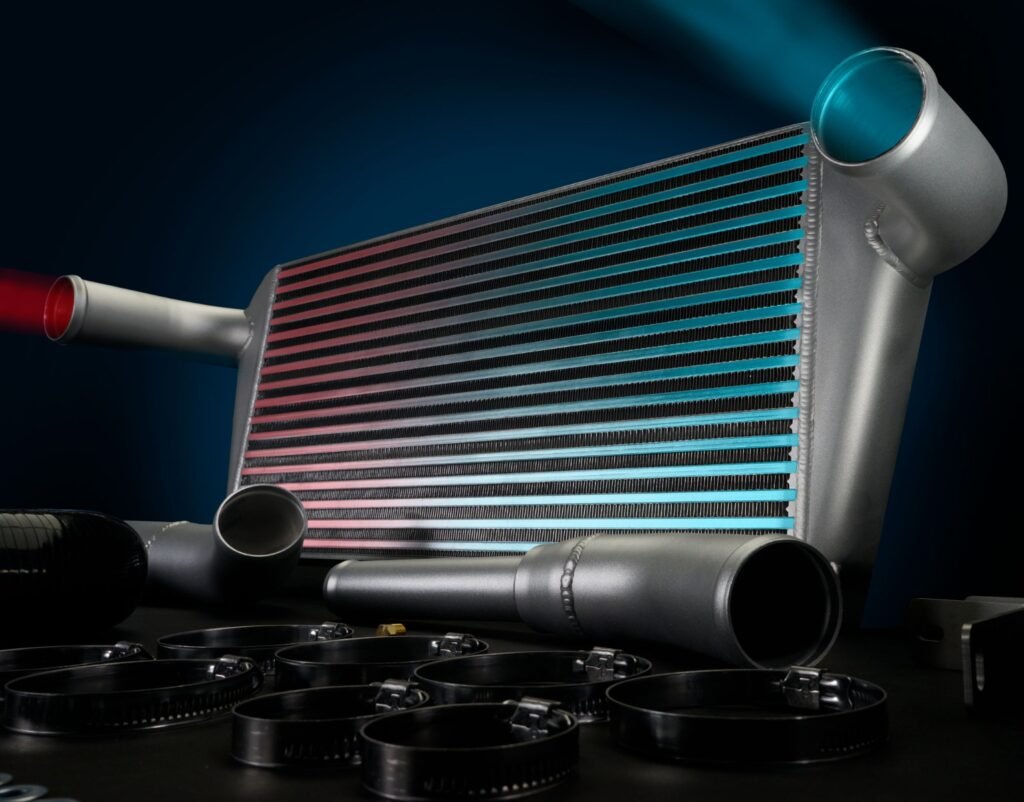With the rise of turbocharged engines, intercoolers have become a critical component for achieving maximum power. By cooling compressed air before it enters the engine, they optimize combustion and efficiency. But stock intercoolers leave much to be desired. We’ll examine how aftermarket systems leverage superior engineering for dramatic improvements.
The Quest for Colder, Denser Air
An intercooler’s sole purpose is transferring heat out of intake air to lower its temperature. But why is colder air better?
Hot air expands, decreasing its density. Less dense air has fewer oxygen molecules per volume. During combustion, this oxygen-lean mixture raises exhaust gas temperatures while hindering power production.
After passing through a turbocharger, air can reach temperatures over 170°F. Cooling it down increases density for a more oxygen-rich charge. This boosts thermal efficiency, allowing the fuel mixture to burn cooler while generating greater cylinder pressures.
Ideally, intercoolers work best when outlet temperatures are within 40°F of ambient conditions. The colder they can get the air, the more power the engine can safely produce.
Design Limitations of Stock Systems
To keep costs down in mass production, stock intercoolers are designed for adequate, reliable operation rather than maximizing performance. This leads to major drawbacks:
Compact Cores – Small, single layer cores lack sufficient surface area for heat transfer. This limits their ability to shed heat quickly at high airflow rates.
Inlet and Outlet Plumbing – Restrictive tubes with tight 90° bends create turbulence that slows airflow velocity through the core. Less exposure time hinders cooling.
Heat Soak – Stock systems often lack insulation on hot side piping and components. This allows heat to soak back into the charge air after the intercooler outlet.
Coolant Heat Transfer – Many factory systems rely solely on air cooling. Lacking a liquid-to-air heat exchanger limits heat shedding capacity.
Power Limiting – Conservative factory tuning accounts for thermal deficiencies. This leaves substantial power still on the table.
While adequate for stock vehicles, factory Banks intercooler systems bottleneck efficiency, performance, and power delivery on modified engines.
Hallmarks of High-Performance Design
Aftermarket intercoolers address factory limitations through optimized airflow and superior cooling efficiency:
- Multilayer Cores – Additional layers increase surface area for better heat transfer at high flow velocities. This quickly sheds heat while minimizing pressure drop.
- Turbulence Reduction – Gradual mandrel bent tubes smooth airflow into the core. Well-shaped inlet and outlet tanks distribute air evenly for maximum exposure.
- Insulated Components – Shielding hot side piping prevents heat soak back through the charge air. This maintains cool temperatures post-intercooler.
- Liquid-to-Air Heat Exchangers – Adding a secondary coolant circuit increases overall heat shedding capacity.
- Higher Volume End Tanks – Large tanks paired with low-restriction inlet/outlets optimize distribution for consistent cooling.
- Higher Flow Tube Diameters – Large piping maintains rapid airflow velocity to the core without choking.
Intercooler Pressure: The Importance of Minimizing Drop
Along with heat transfer, aftermarket intercoolers also focus on minimizing air pressure drop from inlet to outlet. Pressure gets lost via turbulence and resistance through the core. Less drop improves performance:
- Increases Turbo Output – Lower intake resistance allows the turbo to spin faster while maintaining manifold pressure. This pushes more air into the system.
- Prevents Surge – Large pressure drops can mismatch the compressor and turbine sides of a turbocharger. This destabilizes flow, causing surge or even compressor stall.
- Reduces Stress – Minimizing pressure drop lessens strain on other components like hoses and gaskets. This improves durability.
- Maintains Velocity – Smoother, less turbulent airflow has less impact on pressure while still moving rapidly through the core.
Optimizing Intercooler Placement
Location plays a key role in real world effectiveness. Well-designed kits consider:
Proximity – Minimizing the distance between turbo outlet and engine inlet improves throttle response while limiting heat soak opportunities.
Airflow Exposure – Front or low mounting intercoolers in the path of ramming air improves heat shedding.
Liquid Cooling Integration – Ease of access to water lines or radiator facilitates supplemental liquid-to-air cooling.
Hot and Cold Side Separation – Preventing thermal contamination maintains a cooler intake charge. Insulation shields hot components like manifolds.
Moisture Drainage – Vertical mounting aids water drainage from condensation. This prevents flow obstruction and corrosion.
Vehicle Integration – Aesthetic, secure mounting avoids damage from debris while enabling access to other components.
Real World Results from Aftermarket Upgrades
When evaluating intercoolers, dyno testing and track results demonstrate how design differences impact performance.
- 60-100°F lower charge air temperatures
- 6-8 psi higher boost levels and manifold pressures
- 35-60% increases in intake volumetric efficiency
- 75-125 HP gains on modified turbo engines
- More power and torque across full RPM range
- Greatly improved throttle response
- Broadened operating range before heat limiting
- Lower exhaust gas temperatures
Supporting Mods to Maximize Results
Intercoolers work best when paired with other upgrades that increase airflow and engine efficiency:
- Intake Systems – High-flowing cold air intakes minimize inlet restrictions.
- Boost Control – Raising maximum boost pressures forces more airflow through the intercooler.
- Fuel Injectors – Higher capacity injectors add more fuel to match the denser air charge.
- ECU Tuning – Custom engine mapping optimizes timing and fuel for cooler intake temperatures.
- Exhaust Upgrades – Low-restriction headers and free-flowing exhaust help scavenge spent gasses.
When done right, upgraded intercoolers unlock an engine’s potential for huge power gains through improved thermal dynamics and efficiency.
Key Takeaways
- Factory intercoolers sacrifice performance for cost, space savings and reliability.
- Optimized aftermarket systems focus on maximum heat transfer and minimal pressure drop.
- Superior airflow, turbulation reduction and insulation maintain cool, dense air.
- Added liquid-to-air cooling circuits boost heat shedding capacity.
- Lower intake temperatures increase power while allowing safer engine operation.
- When paired with supporting mods, intercooler upgrades are one of the most effective methods for increasing turbocharged engine output.
